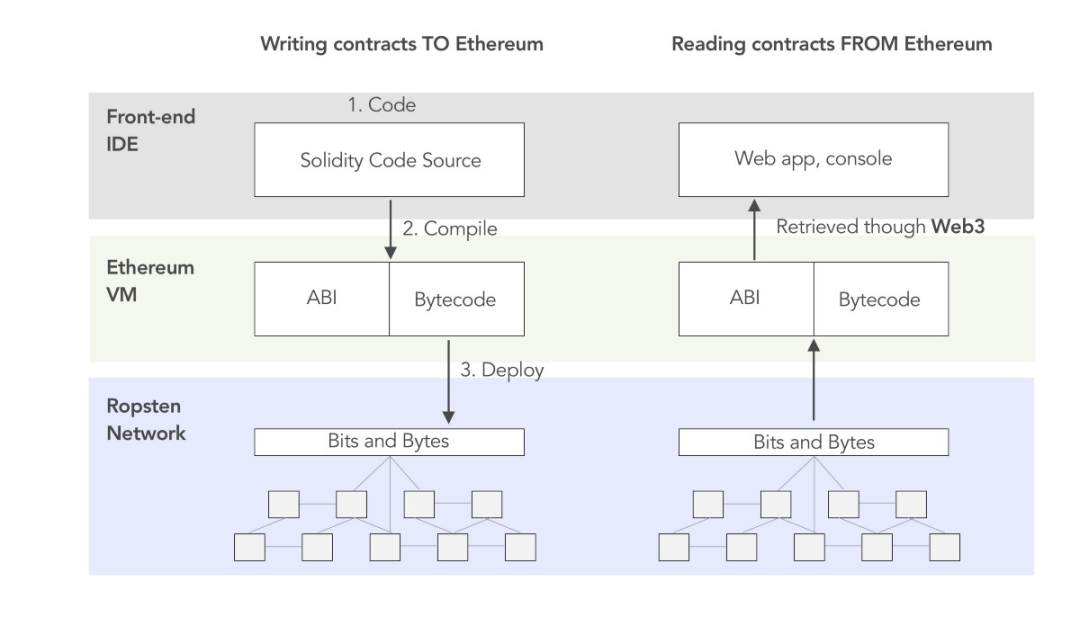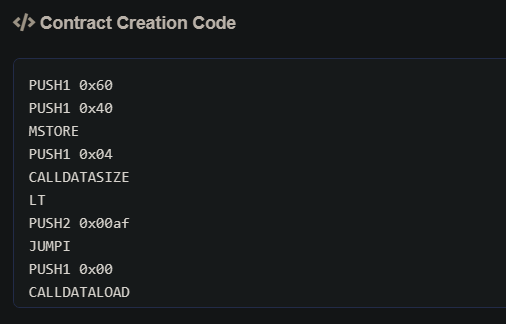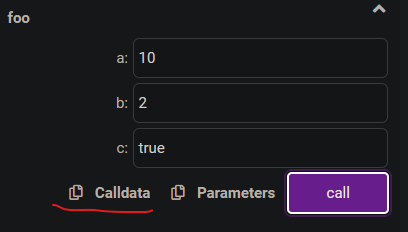前言
当我们需要进行一些链上原始数据分析的时候,常常需要直接对合约的 ABI 信息进行解析。理解 ABI 编解码对于链上数据的分析是很关键的,本文会从 ABI 编码与 Dune Analytics 数据分析两方面来加深对链上原始数据的理解。
ABI 介绍
字节码(bytecode)
ABI (Application Binary Interface) 是应用二进制接口的统称,我们这里讨论的是针对 EVM(Ethereum Virtual Machine) 的 ABI 标准。ABI 是外部账户(EOA)与合约或合约间进行交互的标准,定义了交互信息的编码格式,最直观的理解就是描述了合约中函数接口和事件的签名和参数类型。
Solidity 属于强类型静态语言,编写的合约需要编译成字节码和 ABI 接口定义等数据才能使用。从下图可以看到最后上链的只是字节码,但是进行合约交互时 EVM 同时需要字节码与 ABI 接口定义才能工作。

字节码是十六进制的数字编码的字节数组,EVM 以字节为单位读入字节码并且翻译成对应的汇编指令(EVM 指令集)以进行相应的系统操作。编译后的字节码中是不包含类型信息的,所以单纯的字节码是无法使用的。


接口定义
函数
ABI 接口定义一般是输出为 JSON 格式,其中包含外部可调用接口的名字,参数,类型等信息。
1
function foo(uint a, uint32 b, bool c) external returns(bool){}
下面是这个函数的 ABI 输出, 需要注意uint会转换为全称uint256,接口type有function / constructor / fallback / event , stateMutability 有pure / view / nonpayable / payable。
1
2
3
4
5
6
7
8
9
10
11
12
13
14
15
16
17
18
19
20
21
22
23
24
25
26
27
28
29
30
31
{
// 接口参数
"inputs": [
{
"internalType": "uint256", //第一个参数的内置类型
"name": "a", //第一个参数名字
"type": "uint256"//第一个参数的类型
},
{
"internalType": "uint32",//第二个参数的内置类型
"name": "b",//第二个参数名字
"type": "uint32"//第二个参数的类型
},
{
"internalType": "bool",//第三个参数的内置类型
"name": "c",//第三个参数名字
"type": "bool"//第三个参数的类型
}
],
"name": "foo",//接口名称
//接口返回值信息
"outputs": [
{
"internalType": "bool",
"name": "",
"type": "bool"
}
],
"stateMutability": "nonpayable",//接口对状态变量的读写权限, 默认值
"type": "function"//接口类型
}
状态变量
我们知道合约内声明为public的状态变量,编译时会自动生成一个getter接口, 在 ABI 定义中也有体现。
1
uint256 public num = 0;
1
2
3
4
5
6
7
8
9
10
11
12
13
{
"inputs": [],
"name": "num", //接口名称与变量同名
"outputs": [
{
"internalType": "uint256",
"name": "",
"type": "uint256"
}
],
"stateMutability": "view",//读写权限为 view
"type": "function"//function类型
}
事件
然后事件的定义也会放入 ABI 定义中,区别就是type类型是event,这里的参数可以带indexed标识,用来作为后续交互时的快速检索和过滤。
1
event fooEvent(uint indexed, address indexed, bytes);
1
2
3
4
5
6
7
8
9
10
11
12
13
14
15
16
17
18
19
20
21
22
23
24
25
26
{
"anonymous": false,//事件是否匿名
//事件的参数
"inputs": [
{
"indexed": true,//是否indexed参数
"internalType": "uint256",
"name": "",
"type": "uint256"
},
{
"indexed": true,
"internalType": "address",
"name": "",
"type": "address"
},
{
"indexed": false,
"internalType": "bytes",
"name": "",
"type": "bytes"
}
],
"name": "fooEvent",//事件名称
"type": "event"
}
结构体
单独的结构体无法被外部调用,但是结构体作为参数时,就需要 ABI 来进行定义。
1
2
3
4
5
6
7
struct holder
{
uint index;
address addr;
}
function bar(holder memory _holder) external {}
1
2
3
4
5
6
7
8
9
10
11
12
13
14
15
16
17
18
19
20
21
22
23
24
25
26
{
"inputs": [
{
// 结构体参数
"components": [
{
"internalType": "uint256",
"name": "index", // 结构体中第一个参数名
"type": "uint256" // 结构体中第一个类型
},
{
"internalType": "address",
"name": "addr", // 结构体中第二个参数名
"type": "address" // 结构体中第二个类型
}
],
"internalType": "struct myContract.holder", // 结构体类型
"name": "_holder", // 结构体名字
"type": "tuple" // 结构体类型标识
}
],
"name": "bar", // 函数名
"outputs": [],
"stateMutability": "nonpayable",
"type": "function"
}
ABI 编码
当我们与合约进行交互时,其实是向合约发送了一段 calldata, 这段 calldata 包含了经过 ABI 编码的指定调用函数已经传入的参数等信息,交易信息中的 Input 字段就是这个 calldata 数据。

函数选择器
calldata 的前四个字节(8个十六进制字符)是函数选择器,函数选择器是函数签名的 keccak256 哈希结果的前四个字节。
1
bytes4(keccak256("foo(uint256, uint32, bool)")); // 0x7956f29a
参数编码
从第五个字节开始是参数的编码,分为固定长度类型与动态长度类型编码。各种位长的 int / uint / bytes, address, bool 都是固定长度类型。各种数组,字节数组,string 属于动态长度。如果使用 Remix 交互,可以用下图位置复制 calldata

固定长度类型
固定类型数据一律编码为32字节长度,从左向右按大端字节序存储,不足32字节的部分用0补足。还是用上面的例子来演示
1
2
3
function function foo(uint, uint32, bool) external pure{}
foo(10, 2, true);
1
2
3
4
0x7956f29a
000000000000000000000000000000000000000000000000000000000000000a
0000000000000000000000000000000000000000000000000000000000000005
0000000000000000000000000000000000000000000000000000000000000001
0x7956f29a函数选择器编码000000000000000000000000000000000000000000000000000000000000000a第一个参数10的十六进制编码0000000000000000000000000000000000000000000000000000000000000005第二个参数5的十六进制编码0000000000000000000000000000000000000000000000000000000000000001第三个参数true的十六进制编码
动态长度类型
动态长度类型参数的编码,首先会保存一个偏移值,也就是从参数编码开始到真正存储编码数据的位置的偏移量,然后才是保存动态类型的长度以及其中的数据, 这里调用bar(5, [1, 2], "abcd", "hello, world")
1
2
3
function bar(uint32[] memory, bytes memory) external pure{}
bar([0x456, 0x789], "0x626172");
1
2
3
4
5
6
7
8
0xcd989d6d
0000000000000000000000000000000000000000000000000000000000000040
00000000000000000000000000000000000000000000000000000000000000a0
0000000000000000000000000000000000000000000000000000000000000002
0000000000000000000000000000000000000000000000000000000000000456
0000000000000000000000000000000000000000000000000000000000000789
0000000000000000000000000000000000000000000000000000000000000003
6261720000000000000000000000000000000000000000000000000000000000
cd989d6d函数选择器编码0000000000000000000000000000000000000000000000000000000000000040第一个参数偏移值的十六进制编码00000000000000000000000000000000000000000000000000000000000000a0第二个参数偏移值的十六进制编码0000000000000000000000000000000000000000000000000000000000000002第一个参数的数组大小0000000000000000000000000000000000000000000000000000000000000456第一个参数数组的第一个数据0000000000000000000000000000000000000000000000000000000000000789第一个参数数组的第二个数据0000000000000000000000000000000000000000000000000000000000000003第一个参数的数组大小6261720000000000000000000000000000000000000000000000000000000000第二个参数值,右侧补全到32字节
Solidity 编码接口
abi.encode 可以对参数进行编码
1
2
3
4
5
6
7
8
9
uint x = 10;
address addr = 0x02a5fBb259d20A3Ad2Fdf9CCADeF86F6C1c1Ccc9;
string str = "Hello World";
uint[] array = [1, 2, 3];
function encodeData external view returns(bytes memory)
{
return abi.encode(x, addr, str, array);
}
1
2
3
4
5
6
7
8
9
10
000000000000000000000000000000000000000000000000000000000000000a //x
00000000000000000000000002a5fbb259d20a3ad2fdf9ccadef86f6c1c1ccc9 //addr
0000000000000000000000000000000000000000000000000000000000000080 //str的偏移
00000000000000000000000000000000000000000000000000000000000000c0 //array的偏移
000000000000000000000000000000000000000000000000000000000000000b //str的长度
48656c6c6f20576f726c64000000000000000000000000000000000000000000 //str数据
0000000000000000000000000000000000000000000000000000000000000003 //array的长度
0000000000000000000000000000000000000000000000000000000000000001 //array第一个数据
0000000000000000000000000000000000000000000000000000000000000002 //array第二个数据
0000000000000000000000000000000000000000000000000000000000000003 //array第三个数据
abi.encodePacked 进行压缩编码,编码数据长度减小很多。压缩编码不能与 EVM 交互,适合进行哈希运算或者存储
1
2
3
4
function encodeData external view returns(bytes memory)
{
return abi.encodePacked(x, addr, str, array);
}
1
0x000000000000000000000000000000000000000000000000000000000000000a02a5fbb259d20a3ad2fdf9ccadef86f6c1c1ccc948656c6c6f20576f726c64000000000000000000000000000000000000000000000000000000000000000100000000000000000000000000000000000000000000000000000000000000020000000000000000000000000000000000000000000000000000000000000003
abi.encodeWithSignature 同时编码函数选择器与参数
1
2
3
4
function encodeData external view returns(bytes memory)
{
return abi.encodeWithSignature("foo(uint256, address, string, uint256[2])", x, addr, str, array);
}
1
2
3
4
5
6
7
8
9
10
11
e0d856f6 //函数选择器
000000000000000000000000000000000000000000000000000000000000000a
00000000000000000000000002a5fbb259d20a3ad2fdf9ccadef86f6c1c1ccc9
0000000000000000000000000000000000000000000000000000000000000080
00000000000000000000000000000000000000000000000000000000000000c0
000000000000000000000000000000000000000000000000000000000000000b
48656c6c6f20576f726c64000000000000000000000000000000000000000000
0000000000000000000000000000000000000000000000000000000000000003
0000000000000000000000000000000000000000000000000000000000000001
0000000000000000000000000000000000000000000000000000000000000002
0000000000000000000000000000000000000000000000000000000000000003
abi.encodeWithSelector 第一个参数变为函数选择器,其它时一样的
1
2
3
4
function encodeData external view returns(bytes memory)
{
return abi.encodeWithSelector(bytes4(keccak256("foo(uint256, address, string, uint256[2])")), x, addr, str, array);
}
ABI 调用
solidity
在 solidity 中, call与delegatecall是直接用来发送 abi 编码与合约交互的函数,两个都是address的类型函数,具体区别是调用时上下文对象会有差异,具体差异可以参考[Delegatecall |
WTF学院](https://wtf.academy/solidity-advanced/Delegatecall/)。返回值中有执行结果以及交互合约的返回值。 |
1
2
address.call{ value:发送的ETH金额, gas: 指定的gas数额 }(abi编码)
address.delegatecall{ gas: 指定的gas数额 }(abi编码)
1
2
3
4
5
6
7
address contract_addr = 0x4e15361fd6b4bb609fa63c81a2be19d873717870;
(bool res, bytes memory data) = contract_addr.call{value: msg.value}(
abi.encodeWithSignature("foo(uint256, address, string, uint256[2])", x, addr, str, array);
(bool res, bytes memory data) = contract_addr.delegatecall(
abi.encodeWithSignature("foo(uint256, address, string, uint256[2])", x, addr, str, array);
web3.py
也可以使用 web3.py 和 abi 数据来进行交互。进行读操作的时候使用call, 进行写操作的时候使用transact
1
2
3
4
5
6
7
8
contract_addr = '0x4e15361fd6b4bb609fa63c81a2be19d873717870'
contract_abi = json.loads("./abi.json")
contract_obj = w3.eth.contract(address=contract_addr, abi=contract_abi)
contract_obj.total_supply().call();
contract_obj.functions.transfer(web3.eth.accounts[1], 12345).transact()
ether.js
ether.js 与 EVM 的交互在安全性与便捷性上都很好,而且内置支持了ENS
1
2
3
4
5
6
7
8
9
10
11
12
const abi = [
"function total_supply() public view returns(uint256)",
"function transfer(address, uint) public returns (bool)"
];
const contract_addr = '0x4e15361fd6b4bb609fa63c81a2be19d873717870'
const contract_obj = new ethers.Contract(contract_addr, abi, wallet)
const supply = await contract_obj.total_supply()
const tx = await contract_obj.transfer("vitalik.eth", ethers.utils.parseEther("0.001"))
ABI 数据分析
如果我们使用 Dune Analytics 进行数据分析工作,大概率会从 Decoded Projects 或者 Spells 开始,因为它们都是经过解码并且归类的更高级的查询数据,可以更高效的完成分析工作。但是这些高级数据往往有一定的延迟,或者对于新项目或者冷门项目没有支持。所以很多时候我们还是需要从 Raw 数据开始,亲自解析 calldata 数据进行分析。上文我们学习了 abi 的数据结构与编码,也是为了更好的进行 calldata 数据的分析。
在进行 calldata 分析的时候,有几个常用的函数(基于 Dune Engine V2 Spark SQL):
substring(): 用来按长度读取字节码,ABI 编码数据都是32字节长度,按这个长度读取解析
bytea2numeric_v2: 将字节码转成数值型
hex(string): 将字符串转为字节码
另外几个数据也需要关注:
decimals: 还需要注意我们分析的代币的小数位
topics1: Dune 的 topics1 对应 EVM 事件中的 topic0, 是事件的签名哈希可以用来定位我们希望分析的接口
调用数据查询
从函数调用的 calldata 中直接解析数据的情况比较少,但是某些没有对应日志可以用来分析的情况下就会特别有用。这里我们 Velodrome Finance: Router(0x9c12939390052919aF3155f41Bf4160Fd3666A6f) 这个合约的 swapExactTokensForTokens 接口调用来进行一个分析, 这里我们限定只查询 WETH 兑换 OP 的调用。
1.函数签名和函数选择器确认
Etherscan 打开一个 Velodrome Finance: Router 的交易记录,打开一条 Method 显示 swapExactTokensForTokens 的交易,在Input Data就可以看到函数的签名以及函数选择器(MethodID)

2. 确认函数参数意义
参数中有个 tuple 类型, 需要在合约源码中确认数据结构。


最后可以看到 tuple其实是一个 router 类型数组,router 里面定义了两个 address 与一个 bool 类型。from是源代币的地址,to是要兑换的代币地址, stable代表代币中是否有稳定币
3. 解析 data
因为我们只查询 WETH 兑换 OP 的调用, 所以需要先查询到 WETH 与 OP 的代币合约地址
WETH: 0x4200000000000000000000000000000000000006
OP: 0x4200000000000000000000000000000000000042
然后就可以开是写SQL了,以32字节为一组,按照刚才确定参数类型进行具体值的解析
1
2
3
4
5
6
7
8
9
10
11
12
13
14
15
16
17
18
19
20
21
22
23
24
25
26
27
SELECT
`block_time`,
bytea2numeric_v2(substring(`data`, 11, 64)) / 1e18 AS amountIn, -- 第11个字符开始解析,前面是函数选择器
bytea2numeric_v2(substring(`data`, 11 + 64, 64)) / 1e18 AS amountOutMin,
substring((substring(`data`, 11 + 64 * 3, 64)), 25, 40) AS TO,
bytea2numeric_v2(substring(`data`, 11 + 64 * 4, 64)) AS deadline,
`hash`
FROM
(
SELECT
`block_time`,
`hash`,
`data`
FROM
optimism.transactions
WHERE
`block_time` > NOW() - INTERVAL '1 days' -- 只查询最近一天的记录
AND `to` = '0x9c12939390052919af3155f41bf4160fd3666a6f' -- Velodrome Finance: Router合约地址
AND substring(`data`, 1, 10) = '0xf41766d8' -- swapExactTokensForTokens的函数选择器
AND substring((substring(`data`, 11 + 64 * 6, 64)), 25, 40) = '4200000000000000000000000000000000000006' -- WETH
AND substring((substring(`data`, 11 + 64 * 7, 64)), 25, 40) = '4200000000000000000000000000000000000042' -- OP
AND `success` = TRUE -- 执行成功
)
ORDER BY
1
LIMIT
10

事件数据查询
还是分析swapExactTokensForTokens这个函数调用,这次我们从事件日志的角度来查询。大多数时候都是使用事件日志查询会更加的方便与快捷。
1. 确定要分析的事件
一个交易或者一个函数调用中可能涉及多个事件,需要查看合约源码确定要分析的事件。



确定了要分析的事件后,可以在 Etherscan 上打开一笔相关交易的 logs 页面,查看下事件的签名哈希以及参数

2. 解析 data
因为解析的是swap事件,这个事件的广播是在币对的合约中,所以需要先拿到这个合约地址
OP/USDC: 0x47029bc8f5cbe3b464004e87ef9c9419a48018cd
1
2
3
4
5
6
7
8
9
10
11
12
13
14
15
16
17
18
19
20
21
22
23
24
25
26
27
28
29
SELECT
`block_time`,
`sender`,
`receiver`,
(`amount0In` + `amount1In`) AS amount_in,
(`amount0Out` + `amount1Out`) AS amount_out,
`tx_hash`
FROM
(
SELECT
`block_time`,
`tx_hash`,
substring(`topic2`, 25, 40) AS sender, -- 地址只保留最后40个字符
substring(`topic3`, 25, 40) AS receiver,
bytea2numeric_v2(substring(`data`, 3, 64)) / 1e18 AS amount0In, -- 第一个参数
bytea2numeric_v2(substring(`data`, 3 + 64, 64)) / 1e18 AS amount1In, -- 第二个参数
bytea2numeric_v2(substring(`data`, 3 + 64 * 2, 64)) / 1e18 AS amount0Out -- 第三个参数,
bytea2numeric_v2(substring(`data`, 3 + 64 * 3, 64)) / 1e18 AS amount1Out -- 第四个参数
FROM
optimism.logs
WHERE
`contract_address` = '0x47029bc8f5cbe3b464004e87ef9c9419a48018cd' -- OP/USDC pair 合约
AND `topic1` = '0xd78ad95fa46c994b6551d0da85fc275fe613ce37657fb8d5e3d130840159d822' -- swap事件
AND `block_time` >= NOW() - INTERVAL '1 day'
)
ORDER BY
1
LIMIT
10

参考
SQL on Ethereum: How to Work With All the Data from a Transaction